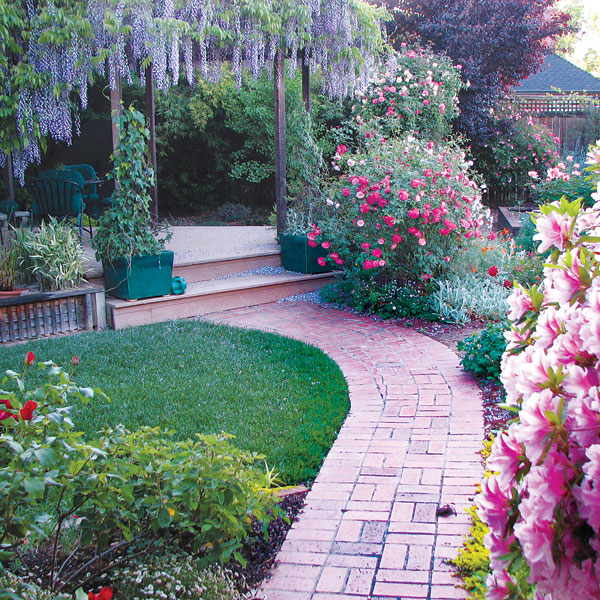Burden or Beauty?
Ways to minimize work in the garden
By Anita Clevenger
December 2019
I didn’t mean to keep it a secret, but only a small circle of family and friends usually see it. Our garden was designed for my obsession with plants and my husband’s addiction to tomatoes, not for garden tours or large-scale entertaining.

I usually would respond, “Not really.” But was that the truth?
My garden has about 75 roses, some of them climbing on arbors or along the fences, with many companion plants. In the back corner, there is an Asian garden complete with bamboo, a gingko and a Buddha statue. There are several raised vegetable beds and a shade garden filled with ferns. Plantings are tucked behind the garage and along a side path. There’s no question that it takes some effort.
However, there are ways to minimize, manage and distribute the labor. I’m blessed with being able to hire others for some of the bigger jobs, such as cutting back the wisteria on the deck cover, and keeping the grass mowed and edged. My husband spends hours tidying. A friend came this year to help deadhead the roses.
One of the most important ways to minimize work is to put the right plant in the right place. Don’t plant something that needs babying or constant cutting back to maintain its size. Consider carefully how big a plant will grow and what it needs to thrive with as little effort on your part as possible. How much sun or shade does it require? What are its watering needs? Is it invasive? Ponder before you plant.
What if a plant slips in that is too labor intensive? As my rose friends say, introduce it to Mr. Shovel. You can move it to a better spot or take it out altogether. As much as I love my wisteria and clumping bamboo, there will be a time when we can’t keep up with them and they will have to go. Just not yet.
The next few months are peak work times and an opportunity to establish a foundation that sustains the garden all year long. Spring bulbs need to go into the ground immediately. Roses must be pruned before Valentine’s Day. Perennials need cutting back and dividing. It’s a good time to move or plant woody plants. Spreading a layer of compost feeds the soil and suppresses weeds. When spring arrives, you and your garden are ready to enjoy it.
Having the right tools for the job also helps. With so many climbing plants, pruning sticks, long-handled pruners and a stable tall ladder are essential. Gardening gauntlets protect from rose prickles. Weeding tools are a personal preference, but all gardeners need a few favorites that work best for them.
The size of a job depends on your standards. If you mulch bare spots and pull out weeds as soon as you see them, weeding doesn’t have to be overwhelming. Not every edge needs to be trimmed neatly. Some plants look great grown into a tangle. I usually deadhead the roses so more will bloom. Some years I don’t bother and the roses do fine. My husband wants the wisteria controlled, so he constantly cuts it back. However, pruning stimulates growth and the vicious cycle continues. If it were up to me, I’d prune it less and wait until winter to tame it once again. We need to pick our battles.
I’ve concluded that it’s not work if you love it. Gardening bolsters the body, mind and soul. Hours in the garden go by in a happy haze of hummingbirds, intoxicating scents and dazzling colors. Lunches together on the deck are the best moments of the day. Our garden is not a burden. It’s a playground.
The UCCE Master Gardeners of Sacramento County “2020 Gardening Guide & Calendar” makes a great holiday gift. This year’s guide, available for $10, includes planting charts and recipes using flowers. To order online or for a list of retail stores selling the guide, visit sacmg.ucanr.edu/gardening_guide.
Anita Clevenger is a platinum Sacramento County Master Gardener. For answers to gardening questions, contact the UC Master Gardeners at (916) 876-5338 or mgsacramento@ucanr.edu, or visit sacmg.ucanr.edu. Follow us on Facebook, Twitter and Instagram: @insidesacramento















